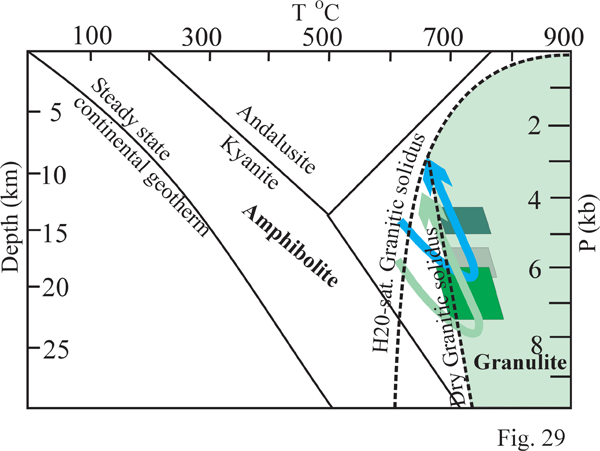The southern Espírito Santo region is a segment of the Araçuaí-Ribeira - West-Congo foldbelt. The main collisional and deformational stage of the Brasiliano orogen, in this region, lasted from ~ 600 to 580 Ma. During this collisional episode folding and thrusting caused considerable crustal thickening and metamorphism increased up to high amphibolite and granulite facies, overprinting older structures.
In the central region of the belt, the intrusion of large batholiths of mainly tonalitic magmas (Fig. 9b) took place ~10 Myr after the amphibolite to granulite facies metamorphism, originating biotite ± hornblende ± plagioclase ± garnet ± hypersthene gneisses (G1 suite). These magmas intruded a thick continental crust of mostly pelitic composition with minor carbonate - and quartz-rich sequences (Paraíba do Sul Complex - Ubu series), characterizing distant and proximal marine environments, respectively.
This thick continental crust underwent different ultrametamorphic conditions in different regions of the belt. While the westernmost granulites from the Caparaó Ridge (Figure 2 and 3) crystallized under P-T conditions exceeding 10 kb and 800 ºC, along the Atlantic coast, the Costeiro Complex shows younger ages. There, P-T conditions remained lower, around 7.5 kb and below 800 ºC (Figure 29). The origin of both high-grade metamorphic rock packages is attributed to a progressive dehydration melting and to the influx of carbonic fluids into the crust [Sluitner & Weber-Diefenbach, 1989; Seidensticker, 1990; Fritzer, 1991; Seidensticker & Wiedemann, 1992]. This process culminated with the crystallization of granodioritic to tonalitic hypersthene gneisses (G2 gneisses and enderbites and G3 enderbitic suites from partial remelting of G2) in the Costeiro Complex. Along the coast this phenomenon took place about 20 Ma later (only around 565 ± 9 Ma) than in the Caparaó region. The granulitization process was followed by widespread migmatization since enough heat was available to cross the solidus for renewed dehydration (Figure 29). Hypersthene-bearing melts crystallized at a concordant U-Pb zircon age of 558 ± 2 Ma (Söllner et al., 1989).
Figure 29. P-T-diagram showing the approximate conditions

P-T-diagram showing the approximate conditions range for two different metamorphic pathes, followed by anatetic events in the Costeiro Complex (after data from Sluitner, 1989). Geothermometry and barometry using orthopyroxene-garnet and orthopyroxene-clinopyroxene pairs as thermometers and orthopyroxene-garnet-plagioclase-quartz as barometer. The melting/anatexis curve for peraluminous (S-Type) granite under water-saturated conditions is from Clemens and Wall (1981). Steady state continental geotherm and dry granitic solidus curve from Philpotts (1990). Explanation and discussion in text.
During the collision, incompatible elements could have been progressively introduced into the mantle through subduction. When collisional deformation ceased, in Cambro-Ordovician times, remarkable amounts of magma intruded the highly metamorphosed gneisses and granulites, during a final thermal event, around 500 Ma (G5 suite, Wiedemann et al., 2002). These are characterized by mantle derived mafic magmas with high values of incompatible elements mingled with felsic magmas.
Tholeiitic (Jacutiga Pluton), medium- to high-K calc-alkaline melts (SAIC, Várzea Alegre, Alfredo Chaves - Iconha, Castelo, Pedra Azul Plutons) with gradational changes into alkaline-richer compositions (Venda Nova, Conceição de Muqui and Torre Plutons) intruded along a relative narrow NE-SW trending strip (Figure 2). This suggests a steeply-dipping plate underneath, due to slab break off at the final stage of the orogen (Wiedemann et al, 2002). Mafic magmas derived from previously enriched mantle were emplaced within the lower crust and provided enough heat to cause a third crustal anatexis event recorded particularly clearly at the margins of these late intrusions. Consequent changes in temperature and volatile pressure conditions originated granitic to charnockitic magmas which mingled with mantle melts on their way through the crust.